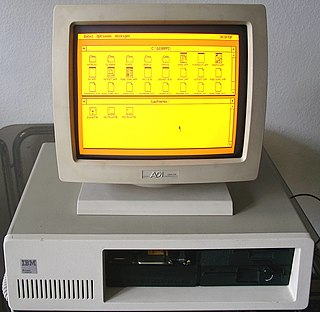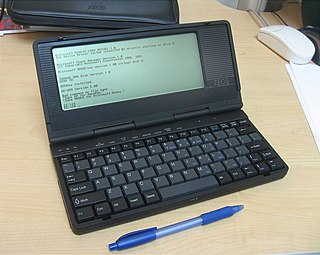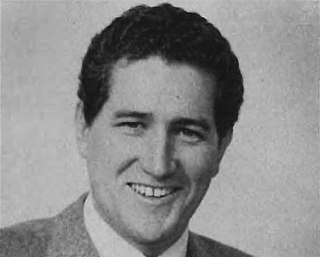Related Research Articles

Atari ST is a line of personal computers from Atari Corporation and the successor to the company's 8-bit home computers. The initial model, the Atari 520ST, had limited release in April–June 1985, and was widely available in July. It was the first personal computer with a bitmapped color graphical user interface, using a version of Digital Research's GEM interface / operating system from February 1985. The Atari 1040ST, released in 1986 with 1 MB of memory, was the first home computer with a cost per kilobyte of RAM under US$1/KB.
Desktop publishing (DTP) is the creation of documents using dedicated software on a personal ("desktop") computer. It was first used almost exclusively for print publications, but now it also assists in the creation of various forms of online content. Desktop publishing software can generate page layouts and produce text and image content comparable to the simpler forms of traditional typography and printing. This technology allows individuals, businesses, and other organizations to self-publish a wide variety of content, from menus to magazines to books, without the expense of commercial printing.

Ventura Publisher was the first popular desktop publishing package for IBM PC compatible computers running the GEM extension to the DOS operating system. The software was originally developed by Ventura Software, a small software company founded by John Meyer, Don Heiskell, and Lee Jay Lorenzen, all of whom met while working at Digital Research. It ran under an included run-time copy of Digital Research's GEM.

GEM is a discontinued operating environment released by Digital Research in 1985. GEM is known primarily as the native graphical user interface of the Atari ST series of computers, providing a WIMP desktop. It was also available for IBM PC compatibles and shipped with some models from Amstrad. GEM is used as the core for some commercial MS-DOS programs, the most notable being Ventura Publisher. It was ported to other computers that previously lacked graphical interfaces, but never gained traction. The final retail version of GEM was released in 1988.
Timeworks Publisher was a desktop publishing (DTP) program produced by GST Software in the United Kingdom and published by Timeworks, Inc., in the United States.

A pocket computer is a class of handheld computer characterized by very short displays and calculator-style alphanumeric keypads. Pocket computers occupy a small footprint, allowing the unit to be comfortably stashed in one's pocket when on the go, and usually weigh less than 1 pound (0.45 kg). Many feature a port for an expansion chassis, allowing the computers to be used with external peripherals.

GEOS is a discontinued operating system from Berkeley Softworks. Originally designed for the Commodore 64 with its version being released in 1986, enhanced versions of GEOS later became available in 1987 for the Commodore 128 and in 1988 for the Apple II. A lesser-known version was also released for the Commodore Plus/4.
GST was a group of computer companies based in Cambridge, England, founded by Jeff Fenton in June 1979. The company worked with Atari, Sinclair Research, Torch Computers, Acorn Computers, Monotype Corporation and Kwik-Fit, amongst others.

Batteries Included was a computer software and hardware company based in the Toronto area. It developed products for the Apple II, Atari 8-bit computers, Atari ST, Commodore 64, and MS-DOS. The company was best known in the 1980s for its PaperClip word processor, which was available for the Atari 8-bit family and Commodore 64, and the DEGAS bitmap painting program for the Atari ST. Batteries Included was acquired by Electronic Arts in 1987.

The IBM Personal Computer XT is the second computer in the IBM Personal Computer line, released on March 8, 1983. Except for the addition of a built-in hard drive and extra expansion slots, it is very similar to the original IBM PC model 5150 from 1981.

The Zeos Pocket PC is a palmtop PC marketed by Zeos International beginning in 1992. The palmtop features an NEC V30 clocked at 7.15 MHz, came shipped with MS-DOS 5.0 in ROM, and has a monochrome LCD capable of displaying graphics at maximum resolution of 640×200 (CGA). These features make the Pocket PC compatible with most IBM PC software out at the time of its release. The Pocket PC is a badge-engineered version of the Tidalwave PS-1000, manufactured by Tidalwave Microtech of Taiwan. It sought to compete with the Poqet PC, another PC-compatible palmtop computer.

Blue Chip Electronics, Inc., later Blue Chip International, was an American computer company founded by John Rossi in 1982. Founded to develop peripherals for Commodore home computers, the company in 1986 began selling low-cost IBM PC compatibles.

TriGem Computer Co., Ltd., was a South Korean personal computer manufacturer and technology company. Established in 1980, TriGem was the first Korean company dedicated to manufacturing computer systems. It delivered Korea's first microcomputer in 1981 and the first Korean IBM PC compatibles in 1984. From that point until its breakup in 2010, it alternated between the first- and second-largest computer manufacturer in South Korea, competing with Samsung Electronics.
The MAD-1 is an IBM PC–compatible desktop computer released by Mad Computers, Inc., of Santa Clara, California, in 1984. The computer was noted among the technology press for its unique, modular design and its 80186 microprocessor, the latter seldom used in PC compatibles. It received positive reviews but sold poorly and was pulled from market a year later.
Visual Technology, Inc., was an American computer company active from 1978 to 1993 and based in Middlesex County, Massachusetts. It produced a wide variety of smart terminals compatible with a wide variety of terminal protocols—mostly those of Digital Equipment Corporation (DEC)—as well as selling terminals with their own bespoke standards. Toward the end of its existence, it focused on the production of X terminals. In 1993, Visual Technology was acquired by White Pine Software.

Brian P. Dougherty is an American software developer and businessman best known as the founder and CEO of Berkeley Softworks, which produced the pioneering GEOS graphical operating system for the Commodore 64 in 1986 and the influential PC/GEOS operating system for the IBM PCs and compatibles in 1990. Dougherty also founded GlobalPC, Airset and Wink Communications. While Dougherty was CEO of GeoWorks, he had been approached by several large technology companies including Microsoft and Apple because of the success of the GEOS operating system. Dougherty attended the University of California, Berkeley, where he graduated with a B.S. in electrical engineering and computer science. When he graduated he began working at Mattel, where he contributed for the design of the Intellivision video game system.

Berkeley Softworks, Inc., later GeoWorks Corporation, was an American software-development company founded by American computing engineer and former Mattel employee Brian P. Dougherty in 1983. It is best known for its GEOS operating systems for GEOS for the Commodore 64, 64c, plus 4, Apple II and the c128 and PC/GEOS, also known as GeoWorks ensemble or simply GeoWorks. The company ceased operations in 2003 after it was bought by various other companies.
Alaris, Inc., was an American computer hardware and software vendor active from 1991 to 2002. During the first half of its existence, the company sold high-performance x86- and PowerPC-based motherboards as either aftermarket upgrades for consumers or for OEMs to put in their own computer systems. Alaris also briefly sold its own computer systems. In 1996, the company pivoted to software, releasing the Videogram suite of video compression software intended for low-bandwidth websites and email. In 2002, the company was acquired in whole by a Japanese electronics conglomerate.
References
- ↑ Staff writer (March 19, 1990). "The 1990 Softletter 100". Softletter. 7 (18). Aegis Resources: 6 et seq– via Gale.
- ↑ Staff writer (December 23, 1990). "Essex joins Timeworks". The Northwest Herald: D1 – via Newspapers.com.
- 1 2 3 4 Linzmayer, Owen (1994). The Mac Bathroom Reader (PDF). Sybex. p. 214. ISBN 978-0-7821-1531-4 – via Vintage Apple.
- 1 2 3 4 5 6 7 Darby, Edwin (February 27, 1984). "File records in computer and ditch that cigar box". Press and Sun-Bulletin: 9 – via Newspapers.com.
- 1 2 Lazarus, George (September 19, 1983). "Fat profits seen in low-cal foods". Chicago Tribune: 3.5 – via Newspapers.com.
- ↑ "Goldberg, Mark L." Chicago Tribune: 10. July 13, 2006 – via Newspapers.com.
- 1 2 Brogan, Daniel (March 20, 1988). "Software Finds Sweet Home Here". Chicago Tribune: 7. Archived from the original on February 22, 2024.
- 1 2 "Computer Program Can Help with Income Taxes". The Tyler Courier-Times: 44. February 19, 1984 – via Newspapers.com.
- ↑ Lazarus, George (August 7, 1984). "Pillsbury losing taste for pasta". Chicago Tribune: 6.3 – via Newspapers.com.
- ↑ "Timeworks, Inc.: Cave of the Word Wizard". The A.V. Guide. Vol. 61–66. Education Screen. 1982. p. 138 – via Google Books.
- 1 2 3 4 5 Staff writer (April 10, 1993). "The 1993 Softletter 100". Softletter. 10 (1). Aegis Resources: 1 et seq– via Gale.
- ↑ Staff writer (August 1985). "SwiftCalc Offers Spreadsheet Capability at a Modest Price". Consumer Software News. 1 (2): 21 – via the Internet Archive.
- ↑ Staff writer (November 1984). "Expanded software". Commodore Computing International. 3 (5). Croftward Limited: 61 – via the Internet Archive.
- ↑ Pearlman, Dara (March 19, 1985). "Speed Through the Reading Barrier". PC Magazine. 4 (6). Ziff-Davis: 175–186 – via Google Books.
- ↑ Bowden, Robert (June 10, 1984). "Timeworks' 'we'll buy it' offer no longer means what you think". Tampa Bay Times: 150 – via Newspapers.com.
- ↑ Marshall, Allan; Ginger Curwen; Robert David Hale (1987). A Manual on Bookselling: How to Open and Run a Bookstore. Harmony Books. ISBN 9780517568880 – via Google Books.
- 1 2 3 Lendino, Jamie (2019). Faster Than Light: The Atari ST and the 16-Bit Revolution. Steel Gear Press. pp. 73–74. ISBN 9781732355217 – via Google Books.
- ↑ Geiger, Peter (January 23, 1989). "Timeworks' new entry goes beyond others". The Akron Business Journal: B7 – via Newspapers.com.
- ↑ Shannon, L. R. (February 24, 1989). "Software library grows for Atari's powerful STs". The Miami Herald: 81 – via Newspapers.com.
- ↑ Fields, Gary V. (July 1986). "Software Reviews: Word Writer 128". Commodore Microcomputers. 7 (4). Contemporary Marketing: 54, 122 – via the Internet Archive.
- ↑ Levine, Martin (March 29, 1987). "Telecommuting Still Growing". Chicago Tribune: 36. Archived from the original on February 23, 2024.
- ↑ Staff writer (January 1988). "What's New from COMDEX". Electronic Learning. 7 (4). Scholastic: 35 et seq– via Gale.
- ↑ Brownstein, Mark (June 13, 1988). "Timeworks Announces GEM-Based Publisher". InfoWorld. 10 (24). IDG Publications: 17 – via Google Books.
- ↑ "Publish-It!". Software Reviews on File. Facts on File, Inc. 1990. p. 415 – via Google Books.
- ↑ Chadwick, Ian (January 1989). "Review: Timeworks Desktop Publisher". ST-Log (27). ANALOG Computing: 88 – via Classic Computer Magazine Archive.
- ↑ Peterson, Tami D. (January 17, 1989). "$295 Publish-It! Works Like Ventura Publisher, Stresses Ease of Use". PC Magazine. 8 (1). Ziff-Davis: 34 – via Google Books.
- ↑ Editors (March 1991). "The 6th Annual Editors' Choice Awards". MacUser. 7 (3). Ziff-Davis: 97 et seq– via Gale.
- ↑ Glinert, Susan (September 1994). "Publishing Without Pain". Computer Shopper. 14 (9). SX2 Media Labs: 360 et seq– via Gale.
- ↑ Staff writer (September 20, 1993). "Burlington's Megalode buys Timeworks". Computer Dealer News. 9 (19). Plesman Publications: 8 – via ProQuest.
- ↑ McCracken, Harry; Jean Osborne (January 16, 1995). "The people's press: Low-cost publishing software". InfoWorld. 17 (3). IDG Publications: 68–83 – via Google Books.
- ↑ Wood, Christina; Peggy Nauts (November 1994). "Shop Talk". PC World. 12 (11). IDG Publications: 31 et seq– via Gale.